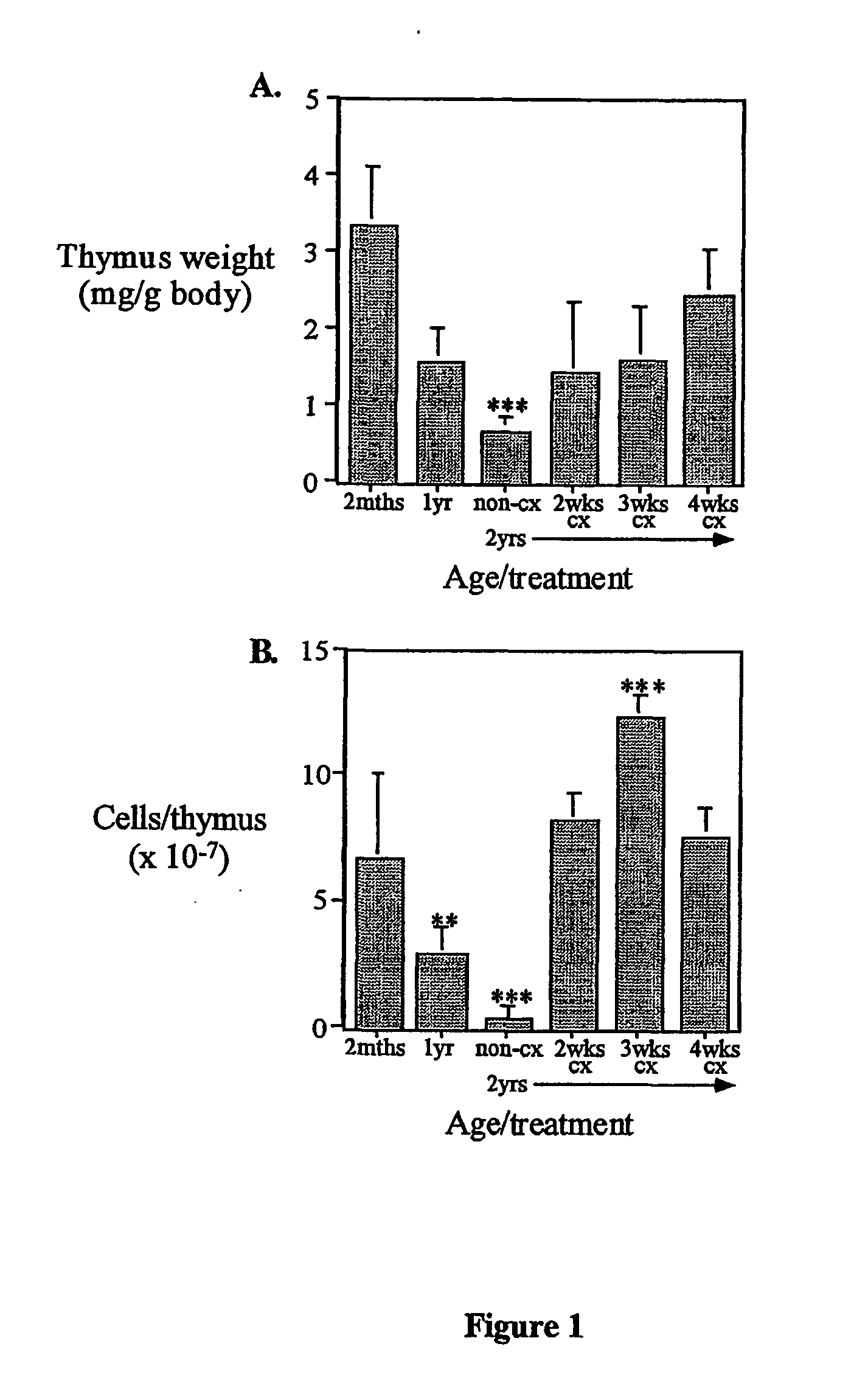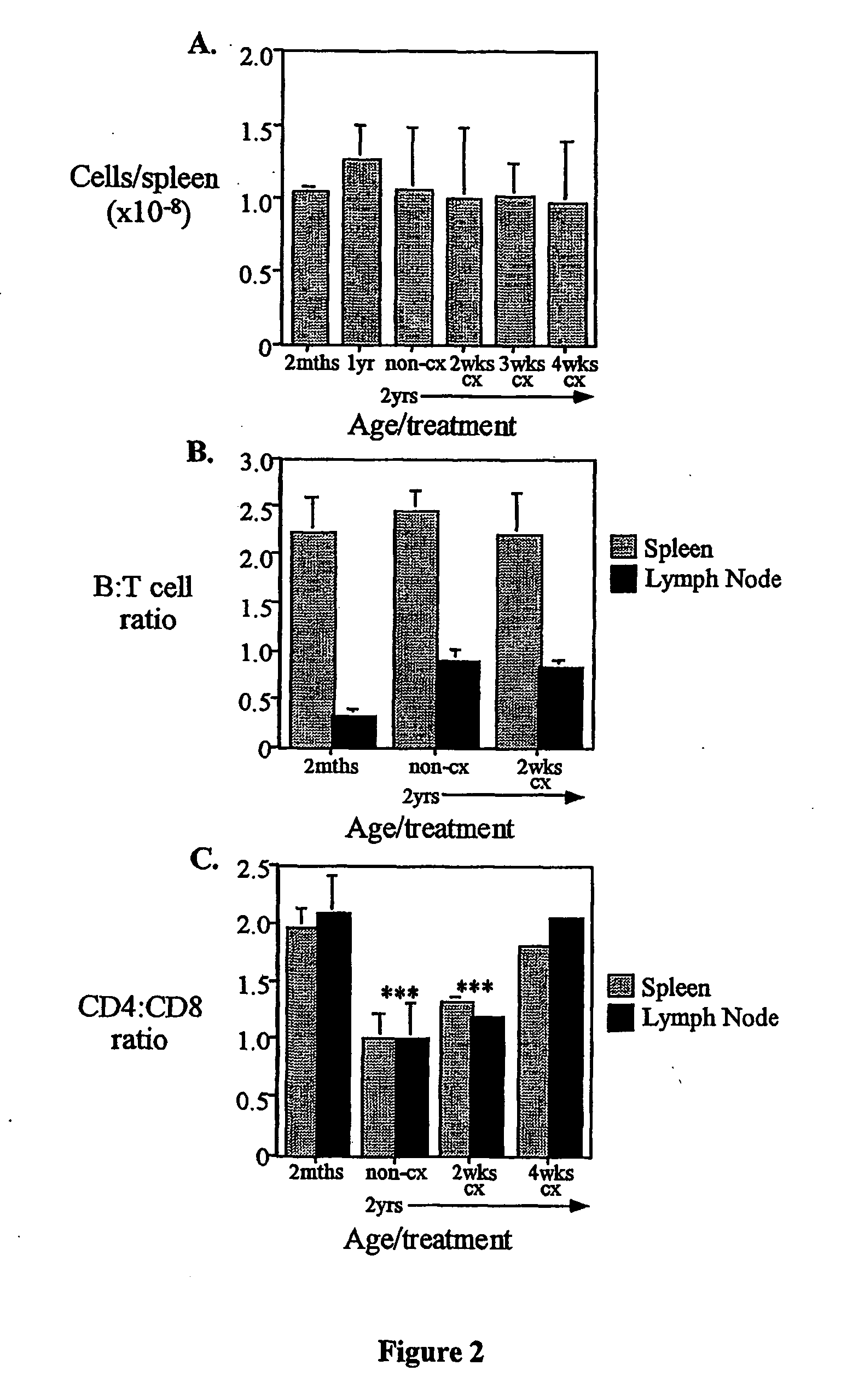Treatment of T cell disorders
a t cell disorder and treatment method technology, applied in the field of t cell disorders, can solve the problems that hsc stem cell therapy has met little or no success to date, and achieve the effects of increasing the uptake of blood-derived hsc, and reducing the risk of hsc infection
- Summary
- Abstract
- Description
- Claims
- Application Information
AI Technical Summary
Benefits of technology
Problems solved by technology
Method used
Image
Examples
example 1
Reversal of Aged-Induced Thymic Atrophy
Materials and Methods
Animals
[0058] CBA / CAH and C57B16 / J male mice were obtained from Central Animal Services, Monash University and were housed under conventional conditions. Ages ranged from 4-6 weeks to 26 months of age and are indicated where relevant.
[0059] Animals were anaesthetised by intraperitoneal injection of 0.3 ml of 0.3 mg xylazine (Rompun; Bayer Australia Ltd., Botany NSW, Australia) and 1.5 mg ketamine hydrochloride (Ketalar; Parke-Davis, Caringbah, NSW, Australia) in saline. Surgical castration was performed by a scrotal incision, revealing the testes, which were tied with suture and then removed along with surrounding fatty tissue.
Bromodeoxyuridine (BrdU) Incorporation
[0060] Mice received two intraperitoneal injections of BrdU (Sigma Chemical Co., St Louis, Mo.) (100 mg / kg body weight in 100 μl of PBS) at a 4 hour interval. Control mice received vehicle alone injections. One hour after the second injection,...
example 2
Reversal of Chemotherapy—or Radiation—Induced Thymic Atrophy
[0092] Castrated mice (either one-week prior to treatment, or on the same day as treatment), showed substantial increases in thymus regeneration rate following irradiation or cyclophosphamide treatment
[0093] In the thymus, irradiated mice show severe disruption of thymic architecture, concurrent with depletion of rapidly dividing cells. Cortical collapse, reminiscent of the aged / hydrocortisone treated thymus, reveals loss of DN and DP thymocytes. There is a downregulation of αβ-TCR expression on CD4+ and CD8+ SP thymocytes—evidence of apoptosing cells. In comparison, cyclophosphamide-treated animals show a less severe disruption of thymic architecture, and show a faster regeneration rate of DN and DP thymocytes.
[0094] By 1 week post-treatment castrated mice showed significant thymic regeneration even at this early stage (FIGS. 6, 7 and 8). In comparison, non-castrated animals, showed severe loss of DN and DP thymocytes (...
example 3
Thymic Regeneration Following Inhibition of Sex Steroids Results in Restoration of Deficient Peripheral T Cell Function
[0097] To determine whether castration can enhance the immune response, Herpes Simplex Virus (HSV) immunisation was examined as it allows the study of disease progression and role of CTL (cytotoxic) T cells. Castrated mice have a qualitatively and quantitatively improved responsiveness to the virus. Mice were immunised in the footpad and the popliteal (draining) lymph node analysed at D5 post-immunisation. In addition, the footpad is removed and homogenised to determine the virus titre at particular time-points throughout the experiment.
[0098] At D5 post-immunisation, the castrated mice have a significantly larger lymph node cellularity than the aged mice (FIG. 10a). Although no difference in the proportion of activated (CD8+ CD25+) cells was seen with age or post-castration, activated cell numbers within the lymph nodes are significantly increased with castration...
PUM
| Property | Measurement | Unit |
|---|---|---|
| time | aaaaa | aaaaa |
| concentration | aaaaa | aaaaa |
| time | aaaaa | aaaaa |
Abstract
Description
Claims
Application Information
 Login to View More
Login to View More - R&D
- Intellectual Property
- Life Sciences
- Materials
- Tech Scout
- Unparalleled Data Quality
- Higher Quality Content
- 60% Fewer Hallucinations
Browse by: Latest US Patents, China's latest patents, Technical Efficacy Thesaurus, Application Domain, Technology Topic, Popular Technical Reports.
© 2025 PatSnap. All rights reserved.Legal|Privacy policy|Modern Slavery Act Transparency Statement|Sitemap|About US| Contact US: help@patsnap.com



